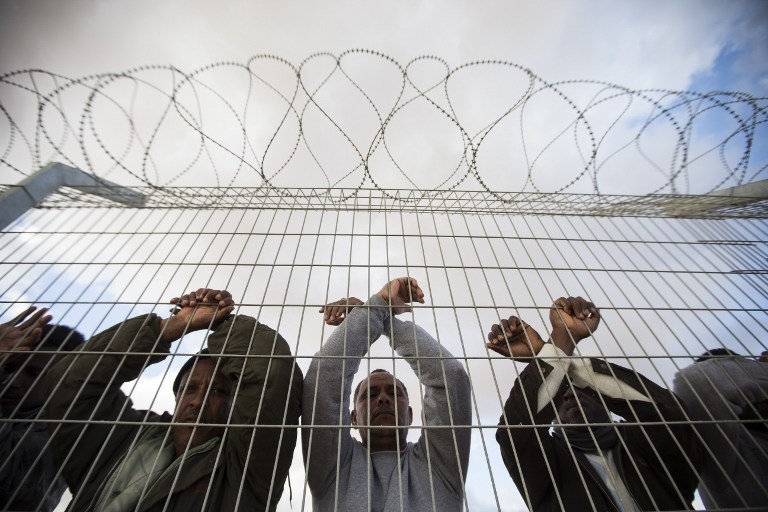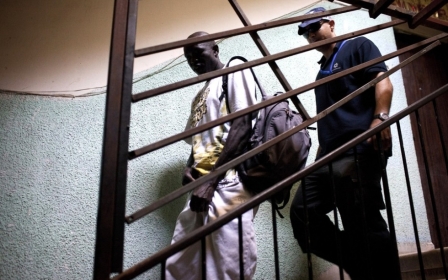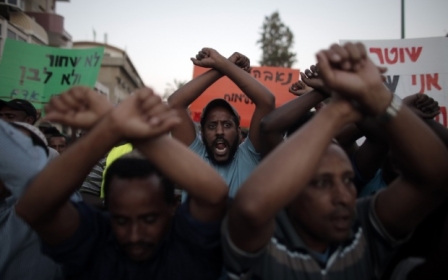'Rwanda or Saharonim': Report slams new Israeli asylum policy

Israel’s Ministry of Interior has begun threatening to deport Eritrean refugees to Rwanda without first hearing their asylum claims, a new report finds.
The 42-page report was released on Wednesday by Hotline for Refugees and Migrants (HRM), an Israeli group that promotes the human rights of undocumented migrants and asylum seekers.
The group interviewed detainees at Holot, a controversial Israeli detention centre for migrants and asylum seekers.
Holot is an “open” facility in southern Israel that houses upwards of 1,900 migrants, who are required to sign in at the centre twice daily, in the morning and the evening.
Detainees are allowed to leave during the day – however, the centre’s location some 80 kilometres from the nearest city, Beersheba, means that many spend their day walking around the desert that surrounds the centre.
Holot was established in 2013 following an amendment to Israel’s Anti-Infiltration Law, which aims to cut down the numbers of migrants, mostly from Sudan and Eritrea, residing in the small country.
Since then, there have been consistent complaints of poor treatment at the centre, where asylum seekers can be held indefinitely.
In June 2014 hundreds of detainees stormed out of the centre and headed towards the border with Egypt, demanding that they be allowed to leave Israel and be resettled elsewhere due to the poor conditions in the country.
The protest ended when Israeli police arrested the asylum seekers near the border and put them on buses back to Holot.
A year on, after several Supreme Court rulings that the centre must be closed, HRM found that services like medical provision in Holot are slowly improving.
'Multimillion dollar' deal for third-country deportations
However, a new Israeli government policy means that asylum seekers are now being asked to choose between being deported to a third country like Rwanda or being held indefinitely in the desert prison of Saharonim.
Rwandan President Paul Kagame confirmed in April that he was finalising what local papers called a “multimillion dollar” deal to accept Eritrean and Sudanese asylum seekers deported from Israel.
Officials in neighbouring Uganda have also hinted at ongoing negotiations with Israel.
Israeli politicians announced the new policy in March, saying it would “encourage infiltrators to leave ... in a safe and dignified manner” and “restore the quality of life” of Israelis living in the south of the country.
Rights groups have slammed the policy, which many have dubbed “Rwanda or Saharonim” – HRM notes that of the 43 Eritreans so far pressured to accept “voluntary return” to Rwanda, 19 had not had their asylum claims processed properly.
Most of the dozens of Eritrean asylum seekers interviewed by HRM said they would rather go to Saharonim prison, an 8,000-capacity desert facility where people can be detained indefinitely.
Many cited the case of Tesfay Kidane, a former Holot detainee who sought asylum in Israel before being persuaded to leave to a third country, believed to be Rwanda, where HRM says migrants regularly have their documents seized by authorities.
Kidane quickly left Rwanda and eventually found his way to Libya – former friends from Holot were later shocked to recognise him in a video released by Islamic State (IS) in April, being beheaded on a beach along with 29 other migrants.
One of the interviewees, named only as AMA, said Israeli immigration officers had summoned him and told him that if he did not agree to leave “voluntarily” to Rwanda, he would be moved to the closed Saharonim prison.
“I told them that I know people who left Israel to Rwanda and received no protection,” AMA told HRM.
“I told them about Tesfay…[who] was murdered by ISIS. I cannot go to Rwanda. If the Israeli government wants me to move to Saharonim, I will move to Saharonim.”
Middle East Eye propose une couverture et une analyse indépendantes et incomparables du Moyen-Orient, de l’Afrique du Nord et d’autres régions du monde. Pour en savoir plus sur la reprise de ce contenu et les frais qui s’appliquent, veuillez remplir ce formulaire [en anglais]. Pour en savoir plus sur MEE, cliquez ici [en anglais].




